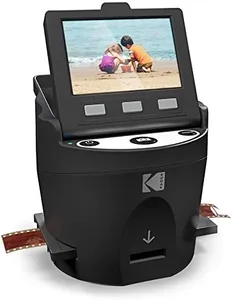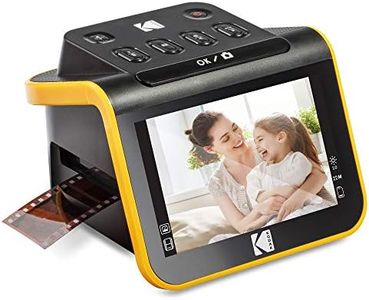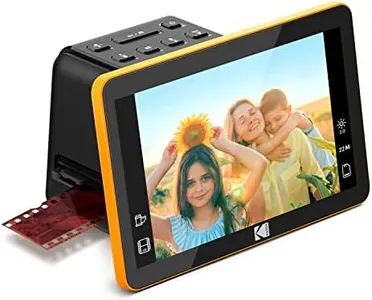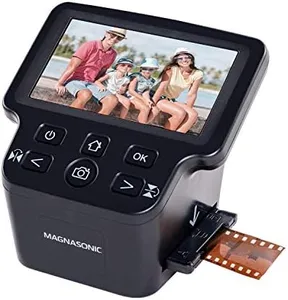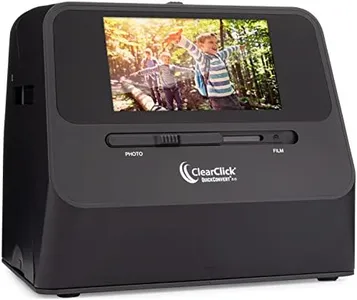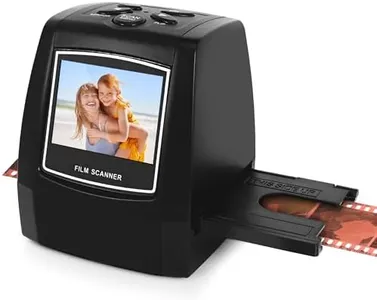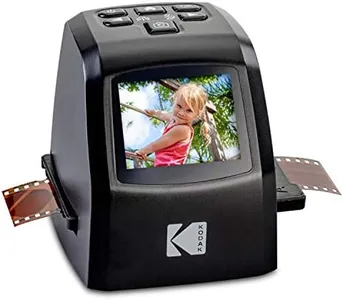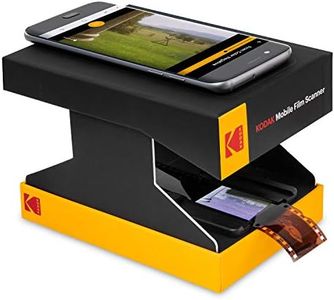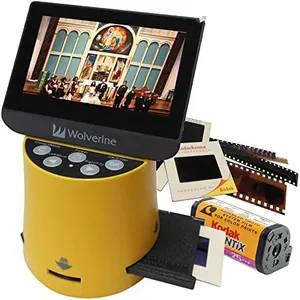7 Best Multi Format Slide Scanners 2025 in the United States
Our technology thoroughly searches through the online shopping world, reviewing hundreds of sites. We then process and analyze this information, updating in real-time to bring you the latest top-rated products. This way, you always get the best and most current options available.

Our Top Picks
Winner
KODAK Slide N SCAN Film & Slide Scanner Digitizer with 5” LCD Screen, Quickly Convert Negatives & Slides to Digital 22MP JPEG Photos, Compatible with 135, 126 and 110 Film & Slides
Most important from
11359 reviews
The KODAK SLIDE N SCAN Film and Slide Scanner stands out with a high resolution of 22MP, ensuring high-quality digital photos from your old slides and negatives. Its large 5” LCD screen is a significant advantage, providing a clear and wide viewing angle for easy previewing and editing. The easy-load film inserts and quick-feeding tray technology make the scanning process straightforward and efficient, which is great for users who are not tech-savvy.
The scanner's compatibility with various film types (35mm, 126, 110) and its USB and HDMI connectivity options offer versatile usage, making it suitable for different users and devices. Additionally, it supports SD and SDHC cards up to 32GB, although these are not included, which might be a slight inconvenience for some users. The advanced capture software is user-friendly, allowing single-touch editing for enhancing and converting photos.
The scanner's compact size and lightweight build (only 1 pound) add to its portability, making it easy to move and store. However, it’s worth noting that it might not cater to professional photographers needing extremely high color depth and dynamic range. The included accessories such as the cleaning brush and film adapters add to its convenience, but the absence of detailed color depth specifications is a slight drawback. The KODAK SLIDE N SCAN is ideal for hobbyists and families wanting to preserve old photo memories without the need for advanced technical skills or professional-level output.
Most important from
11359 reviews
Kodak Slide N Scan Max Digital Film Slide Scanner, Black/Yellow (RODFS70)
Most important from
1381 reviews
The KODAK 7" Digital Film Scanner is designed to breathe new life into your old photo memories by converting 35mm, 126, and 110 film negatives and slides into digital files. With a resolution of up to 22MP, it provides clear and detailed images, making it a great choice for preserving cherished photos. The large 7-inch LCD display is a standout feature, allowing you to preview and edit photos directly on the device, which can also double as a digital picture frame for easy sharing with friends and family.
The scanner is user-friendly, thanks to its quick-feeding tray technology and single-touch editing options, which simplify the scanning process without the need for complex settings. It also supports SD and SDHC cards up to 32GB for easy storage of scanned images. The scanner connects via USB to any type-C USB-enabled computer, ensuring broad compatibility. Weighing just over a pound and compact in size, it's easy to handle and store.
The KODAK 7" Digital Film Scanner offers a good balance of features and ease of use, particularly for those looking to digitize old photos with minimal fuss.
Most important from
1381 reviews
Kodak SCANZA Digital Film & Slide Scanner – Converts 35mm, 126, 110, Super 8 & 8mm Film to JPEG with 3.5" LCD, Easy-Load Inserts & Adapters
Most important from
11444 reviews
The Kodak SCANZA Digital Film & Slide Scanner is designed to quickly convert a variety of film formats (35mm, 126, 110, Super 8, and 8mm) to JPEG digital files, making it a versatile choice for those with diverse collections of old negatives and slides. It boasts a strong resolution of 7200 DPI and a color depth of 24 bpp, which should provide detailed and vibrant digital reproductions of your films. The 3.5” LCD screen is a handy feature for easy viewing and editing, with adjustable brightness and tilt functionality for user comfort.
The scanner comes with multiple film inserts and adapters, making the process of loading and scanning different film types straightforward and efficient. However, it’s important to note that it doesn’t support films other than the specified formats. Compatibility with both Mac and PC is a plus, and the inclusion of USB and HDMI connectivity options provides flexibility in how you use and view your scans. The SCANZA is compact and lightweight at just 1 pound, making it quite portable and easy to store.
On the downside, the device doesn’t include an SD card (required for saving scanned images), so you’ll need to purchase one separately. Additionally, while the scanner is generally user-friendly, the software interface might feel a bit basic compared to more advanced programs. This product is best suited for hobbyists and individuals looking to digitize their film collections with a minimal fuss.
